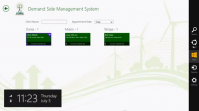Writing business apps for Microsoft's Windows 8: Developers weigh in

Of the new Windows 8 apps Microsoft and its partners have shown and discussed publicly, the vast majority are consumer-focused. But behind the scenes, there are some developers -- beyond those affiliated with Microsoft -- who are working on creating business-focused Windows 8 programs.

I recently interviewed three such shops that have been planning and building Windows 8 business apps.
Microsoft partner and IT services provider Sogeti has been working on building several proof-of-concept Windows 8 apps since January 2012. Sogeti is building apps for power and electric companies, among others, that "embody the spirit of Metro, but aren't too flashy," said Darren Baker, Sogeti's Redmond-based Global Business Development Director.
Sogeti is out to prove a line-of-business app can be a good citizen in the Windows 8 Metro/modern style world.
Here's Sogeti's video overview of some of the Windows 8 proof-of-concept apps it has built:
"Microsoft is adamant about not paying for app development," explained Baker. "Instead, they come to us and say, we have a customer. Microsoft pays a bit for our time, and then, if a customer ends up buying (Windows 8) tablets to further the development, it's considered a win because it stopped an iPad sale."
Sogeti has built four proof-of-concept Windows 8 apps for customers in the U.S. and another 10 in Europe. Even though Sogeti has many developers with HTML5 and JavaScript exepertise, the company has gravitated toward using XAML and C# using Visual Studio 2012 to build its prototype apps, officials said, since those languages and tools were what the mobile app team has used in building Windows Phone apps.
"There is a learning curve with WinRT APIs, but Microsoft has helped us," said Samidip Basu, a Microsoft Mobility Solutions Lead for Sogeti U.S.
In developing the proof-of-concept apps, Sogeti has focused on making sure "it's not a disjointed experience" for customers, Basu said. Sogeti also is focusing on making use of the Charms, app bars, search and share and new touch gestures, even though not all of these features need to be turned on right away. Sogeti also created demo apps which made use of Azure and SQL Azure, as well as a stylus for drawing, Basu said.
Microsoft's proof-of-concept program terms stipulated participants provide two to three iterations per project. Projects typically involved three to four devs and one designer.
Like Sogeti, C-Labs Software also prefers Silverlight/XAML to HTML and JavaScript for developing Windows 8 business applications.
C-Labs has built a middleware framework, known as C-DEngine, that uses connected devices to deliver real-time distributed business intelligence to manufacturers. CEO and foudner Chris Muench has developed a related Windows 8 prototype application called "See My House" which provides home-automation monitoring. Muench said the app ultimately could be sold to consumers or businesses, but that it's definitely an "enterprise-class" app.
It took Muench a half day to bring the user interface of his app over to Windows 8's Metro/modern style. He was able to migrate his controls and build new touch-enabled ones. His next step is to make use of the Charms and Contracts features in Windows 8.
Muench said the commonalities in the Silverlight and XAML are what helped him get his prototype built so quickly.
"Silverlight is being downplayed by Microsoft evangelists and devs, but I still like it, even if they call it XAML," Muench said. "I think HTML and JavaScript is much less secure than with C#/XAML. And encryption is a nightmare with JavaScript."
On the plus side, the full-screen app concept enforced in the Metro/modern environment in Windows 8 makes a lot of sense in the industrial-automation world; the overlapping windows in current Windows versions created a hurdle in this space, Muench said. But to its detriment, Microsoft isn't talking enough about side-loading and how Metro/modern-style business apps will work in the Windows Store, particularly regarding the certification requirements for these kinds of apps, he said.
Not every business app seems destined for the Windows 8 Metro/modern environment, however. As was true with every previous version of Windows, apps that require access to the "guts" of Windows -- the file system, registry, etc. -- often are problematic to port. That's what Laplink has found to be the case this time around, as well.
"Our app won't work with Metro. It needs access to everything on a PC," said Laplink CEO Thomas Koll.
Laplink's sync product will still work in the Desktop app/environment available on Intel/AMD-based Windows 8 PCs and tablets. But Microsoft won't allow the direct sale/download of non-Metro-style apps through its Windows Store, officials have said. (Desktop/legacy apps will be allowed to be listed in the Store, but not serviced and sold.)
Microsoft, Google, Apple and Amazon are the four ecosystems that independent software vendors (ISVs) need to support or they "won't exist," Koll said. But all four increasingly are restricting developers in their respective walled gardens, Koll noted.
There is a silver lining to this Metro-style cloud for Laplink, however.
"It's good for our migration tool (PCmover) business that Microsoft is changing its operating system," Koll noted, as many of those looking to move from previous versions of Windows to Windows 8 will likely need some help.